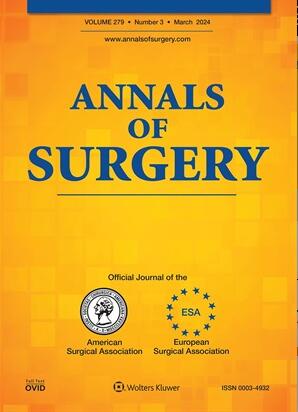肝动脉灌注化疗与经动脉放射栓塞治疗不可切除的结直肠癌肝转移瘤的比较。
IF 6.4
1区 医学
Q1 SURGERY
引用次数: 0
摘要
目的:本研究评估不可切除的结直肠癌肝转移(CRLM)患者接受肝动脉灌注化疗(HAI)和经动脉放射栓塞(TARE)的预后。背景数据:对于不可切除的CRLM,最常见的肝定向治疗包括HAI和TARE。方法在这项回顾性队列研究中,将在一个大容量中心接受HAI治疗的不可切除的CRLM患者与在其他五个机构接受TARE治疗的患者进行比较。在治疗前接受的化疗线内进行倾向评分匹配(treatment-naïve;1条线;两条线;3-4行),包括基线人口统计学、肝外疾病(EHD)、既往化疗、无病间期和从初诊到HAI/TARE的间期。对配对组进行总生存期(OS)分析比较。结果共检出HAI患者708例,TARE患者481例。大多数患者(84%)在HAI/TARE之前接受了化疗。HAI患者更年轻(中位年龄:54对62),在治疗时更有可能有EHD的证据(65%对60%)。在接受单线化疗的493例患者中,166例(34%)匹配。在接受1线化疗(HAI:83, TARE:83)或2线化疗(HAI:80, TARE:80)的匹配患者中,与HAI相比,TARE患者的全因死亡风险显著增加[HR:1.46 (95%CI:1.02-2.08)和HR:1.96 (95%CI:1.32-2.89)]。在HAI队列中,更频繁地转向切除和同时使用全身化疗。在接受3-4线化疗(HAI:50, TARE:50)的匹配患者中,HAI和TARE的OS无差异[HR:0.88 (95%CI:0.57-1.35)],两组转换率均为4%。在按治疗线分层的匹配队列中,接受HAI和TARE治疗的患者在一线或二线化疗后的生存率似乎存在差异。在难治性环境中,TARE和HAI的结果没有显著差异。本文章由计算机程序翻译,如有差异,请以英文原文为准。
Hepatic Artery Infusion Chemotherapy Compared to Transarterial Radioembolization For Unresectable Colorectal Liver Metastases.
OBJECTIVE
This study evaluates outcomes for patients with unresectable colorectal liver metastases (CRLM) undergoing hepatic artery infusion chemotherapy (HAI) and transarterial radioembolization (TARE).
SUMMARY BACKGROUND DATA
The most common liver-directed therapies for unresectable CRLM include HAI and TARE.
METHODS
In this retrospective cohort study, patients with unresectable CRLM treated with HAI at one high-volume center were compared with patients treated with TARE at five other institutions. Propensity score matching was performed within lines of chemotherapy received prior to treatment (treatment-naïve; 1-line; 2-lines; 3-4 lines) using baseline demographics, extrahepatic disease (EHD), prior chemotherapy, disease-free interval, and interval from primary diagnosis to HAI/TARE. Overall survival (OS) analysis was conducted to compare the matched groups.
RESULTS
A total of 708 HAI patients and 481 TARE patients were identified. The majority of patients (84%) received chemotherapy prior to HAI/TARE. HAI patients were younger (median age:54 vs. 62) and more likely to have evidence of EHD at time of treatment (65% vs. 60%). Of the 493 patients who received 1-line of chemotherapy, 166 (34%) were matched. Among matched patients who received 1-line (HAI:83, TARE:83) or 2-lines of chemotherapy (HAI:80, TARE:80), TARE patients had a significantly increased risk of all-cause mortality compared to HAI [HR:1.46 (95%CI:1.02-2.08) and HR:1.96 (95%CI:1.32-2.89)]. More frequent conversion to resection and use of concurrent systemic chemotherapy were also seen in the HAI cohort. Among matched patients who received 3-4 lines of chemotherapy (HAI:50, TARE:50), there was no difference in OS between HAI and TARE [HR:0.88 (95%CI:0.57-1.35)] and rate of conversion to surgery was 4% for both groups.
CONCLUSIONS
Within matched cohorts stratified by lines of therapy, there appear to be differences in survival for patients treated with HAI and TARE after first or second-line chemotherapy. Outcomes after TARE and HAI are not significantly different in the refractory setting.
求助全文
通过发布文献求助,成功后即可免费获取论文全文。
去求助
来源期刊

Annals of surgery
医学-外科
CiteScore
14.40
自引率
4.40%
发文量
687
审稿时长
4 months
期刊介绍:
The Annals of Surgery is a renowned surgery journal, recognized globally for its extensive scholarly references. It serves as a valuable resource for the international medical community by disseminating knowledge regarding important developments in surgical science and practice. Surgeons regularly turn to the Annals of Surgery to stay updated on innovative practices and techniques. The journal also offers special editorial features such as "Advances in Surgical Technique," offering timely coverage of ongoing clinical issues. Additionally, the journal publishes monthly review articles that address the latest concerns in surgical practice.
 求助内容:
求助内容: 应助结果提醒方式:
应助结果提醒方式:


